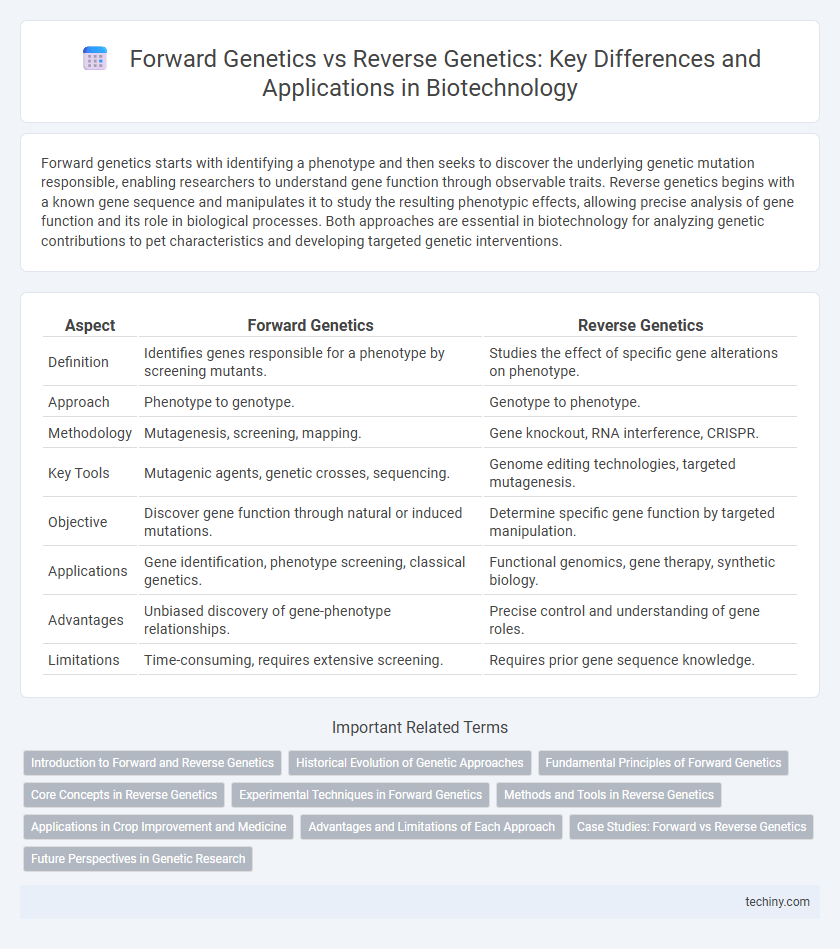Forward genetics starts with identifying a phenotype and then seeks to discover the underlying genetic mutation responsible, enabling researchers to understand gene function through observable traits. Reverse genetics begins with a known gene sequence and manipulates it to study the resulting phenotypic effects, allowing precise analysis of gene function and its role in biological processes. Both approaches are essential in biotechnology for analyzing genetic contributions to pet characteristics and developing targeted genetic interventions.
Table of Comparison
| Aspect | Forward Genetics | Reverse Genetics |
|---|---|---|
| Definition | Identifies genes responsible for a phenotype by screening mutants. | Studies the effect of specific gene alterations on phenotype. |
| Approach | Phenotype to genotype. | Genotype to phenotype. |
| Methodology | Mutagenesis, screening, mapping. | Gene knockout, RNA interference, CRISPR. |
| Key Tools | Mutagenic agents, genetic crosses, sequencing. | Genome editing technologies, targeted mutagenesis. |
| Objective | Discover gene function through natural or induced mutations. | Determine specific gene function by targeted manipulation. |
| Applications | Gene identification, phenotype screening, classical genetics. | Functional genomics, gene therapy, synthetic biology. |
| Advantages | Unbiased discovery of gene-phenotype relationships. | Precise control and understanding of gene roles. |
| Limitations | Time-consuming, requires extensive screening. | Requires prior gene sequence knowledge. |
Introduction to Forward and Reverse Genetics
Forward genetics identifies genes responsible for specific phenotypes by screening mutants and mapping mutations, enabling the discovery of gene functions through observed traits. Reverse genetics starts with a known gene sequence and investigates its function by analyzing phenotypic effects after targeted gene manipulation, such as gene knockouts or RNA interference. Both approaches are fundamental in biotechnology for understanding gene roles and developing genetic models.
Historical Evolution of Genetic Approaches
Forward genetics, originating in the early 20th century with classical mutagenesis and phenotype-driven gene identification, laid the foundation for understanding gene function by linking mutations to observable traits. Reverse genetics, emerging in the late 20th century with advancements in molecular biology techniques such as gene cloning and targeted gene disruption, enabled precise manipulation of specific genes to study their functions directly. The historical evolution from forward to reverse genetics reflects a shift from phenotype-based discovery toward genotype-driven experimental design, enhancing the resolution and efficiency of genetic research in biotechnology.
Fundamental Principles of Forward Genetics
Forward genetics involves identifying genes responsible for a specific phenotype through mutagenesis followed by phenotypic screening, enabling the discovery of gene function without prior genetic information. This approach relies on random mutation induction, such as chemical mutagens or radiation, to generate diverse genetic variants that are then analyzed to link observable traits to underlying genetic changes. Forward genetics is fundamental in elucidating gene-to-phenotype relationships, providing critical insights into gene functions and biological pathways through unbiased genetic analysis.
Core Concepts in Reverse Genetics
Reverse genetics involves manipulating specific genes to observe phenotypic effects, using techniques like gene knockout, RNA interference, and CRISPR-Cas9. This approach starts with known gene sequences to elucidate gene function, contrasting with forward genetics that begins with phenotypes to identify causal genes. Core concepts include targeted gene disruption and functional analysis, enabling precise investigations of gene roles in development, disease, and molecular pathways.
Experimental Techniques in Forward Genetics
Forward genetics employs mutagenesis combined with phenotype screening to identify gene functions without prior genetic knowledge. Techniques such as chemical mutagenesis, radiation, and insertional mutagenesis generate mutations, while positional cloning and genetic mapping help locate the mutated genes responsible for observed traits. This approach enables discovery of novel genes based on phenotype-driven analysis, making it a powerful tool for uncovering genetic pathways and molecular mechanisms in diverse organisms.
Methods and Tools in Reverse Genetics
Reverse genetics employs targeted gene disruption techniques such as CRISPR-Cas9, RNA interference (RNAi), and site-directed mutagenesis to study gene function by analyzing phenotypic effects. These methods enable precise manipulation of specific DNA sequences, facilitating functional annotation and validation of gene roles in complex biological pathways. High-throughput sequencing and gene editing platforms are essential tools that drive advancements in reverse genetics applications in biotechnology.
Applications in Crop Improvement and Medicine
Forward genetics accelerates crop improvement by identifying genes responsible for desirable traits through phenotype screening, enabling the development of pest-resistant and drought-tolerant varieties. Reverse genetics facilitates precise gene function analysis by targeted gene editing tools like CRISPR-Cas9, advancing personalized medicine and the creation of genetically modified crops with enhanced nutritional content. Both approaches integrate genomics and molecular biology techniques to optimize breeding strategies and therapeutic interventions in agriculture and healthcare.
Advantages and Limitations of Each Approach
Forward genetics enables the identification of genes responsible for specific phenotypes through mutagenesis and screening, offering a powerful tool for discovering novel gene functions but may require extensive time and resource investment. Reverse genetics allows targeted manipulation of known genes to study their function, providing precise control and insights into gene roles, yet it depends on prior gene sequence knowledge and may not reveal unexpected genetic interactions. Both approaches complement each other in biotechnology research, balancing comprehensive discovery with focused analysis while facing limitations in scalability and functional complexity.
Case Studies: Forward vs Reverse Genetics
Forward genetics utilizes mutagenesis and phenotype screening to identify genes responsible for specific traits, as demonstrated in classic studies on Drosophila eye color mutations. Reverse genetics involves targeted gene manipulation, such as CRISPR-Cas9-mediated knockout in mice, to determine gene function by observing resulting phenotypes. Case studies comparing both approaches highlight forward genetics' strength in discovering unknown genes, while reverse genetics excels in validating gene roles in complex pathways.
Future Perspectives in Genetic Research
Forward genetics, which identifies genes based on phenotypic traits, and reverse genetics, targeting specific genes to study their functions, are both pivotal in advancing genetic research. Future perspectives emphasize integrating CRISPR-Cas9 technology with these approaches to enhance precision in gene editing and functional genomics. Emerging trends include combining high-throughput sequencing and machine learning to accelerate gene discovery and understand complex genetic networks in biotechnology.
**Forward genetics vs Reverse genetics** Infographic

 techiny.com
techiny.com